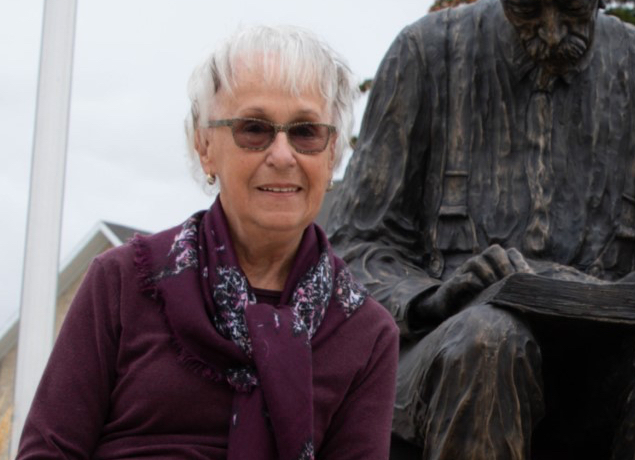
Share this publication:
To mark the 150th anniversary of the arrival of the first residents in St. Jean Baptiste, a life-size bronze statue of two village pioneers, Antoine Vandal and Raymond Rajotte, will be unveiled on September 13 on the church grounds at 151 Caron Street. Read more
The event organizing committee benefited from the help and knowledge of Paulette (Rose) Vermette, who is the great-granddaughter of Antoine Vandal and very knowledgeable about her family history. “My parents were genealogy enthusiasts,” she says. “They did a great deal of research into our family history. In 1982, my brother Denis also got involved in researching the family’s genealogy. I was sort of his secretary, gathering together all the documents.”
While historical research has been a family passion for many years, it was mostly “personal curiosity” that prompted Paulette Vermette to volunteer as a consultant for the committee in charge of the 150th celebrations. “I would always hear my grandmother, Virginie Vandal, talking about her father, Antoine Vandal. I thought my historical knowledge about my ancestor might be useful.”
Paulette Vermette is also a cousin of Raymond Rajotte. “It’s kind of interesting to think that I’m related to both men in the statue! Antoine Vandal on my father’s side, and Raymond Rajotte on my mother’s.”
Why is 1869 considered to be the year the first inhabitants came to St. Jean Baptiste? “Actually, 1869 is the year Antoine Vandal arrived in the village to settle permanently. Naturally, people lived in St. Jean Baptiste before that, but the population was mostly nomadic. People would come, spend some time here and then leave again. Antoine Vandal was the first person to move here permanently. His home was always open to missionaries and other travelers.”
While Antoine Vandal was one of the first people to live in St. Jean Baptiste year-round in 1869, three years after his arrival, in 1872, “the government launched a campaign to encourage French-Canadians to come to Manitoba,” says Vermette. “For example, newcomers were offered 160 acres of land.”
“Two years later, in 1874, a chapel built in St. Jean Baptiste was a sign that the residents were there to stay. However, the village’s first church wasn’t built until 1877, coinciding with the arrival of new settlers from Quebec.”
The descendant of the first pioneer recalls that there was a blending of two cultures in St. Jean Baptiste from the village’s earliest days: “There has always been a nice mix of Métis and eastern French-Canadian culture.”
That mix is symbolized in the 150th anniversary statue. “The photograph of Antoine Vandal and Raymond Rajotte, which was reproduced in the life-size sculpture, is a beautiful portrait of an older Métis man, Antoine Vandal, sitting with a French-Canadian boy, Raymond Rajotte. It represents the two cultures living side by side in St. Jean Baptiste perfectly.”
St. Jean Baptiste’s 150th anniversary celebrations are a wonderful opportunity for remembering all the cultural blends making up the village. For Paulette Vermette, who has lived all her life in St. Jean Baptiste, the unveiling of the commemorative statue will have an even greater personal connection.
© 2025 , Conseil de développement des municipalités bilingues du Manitoba. All rights reserved.
Website : InnovaCom Marketing et Communication